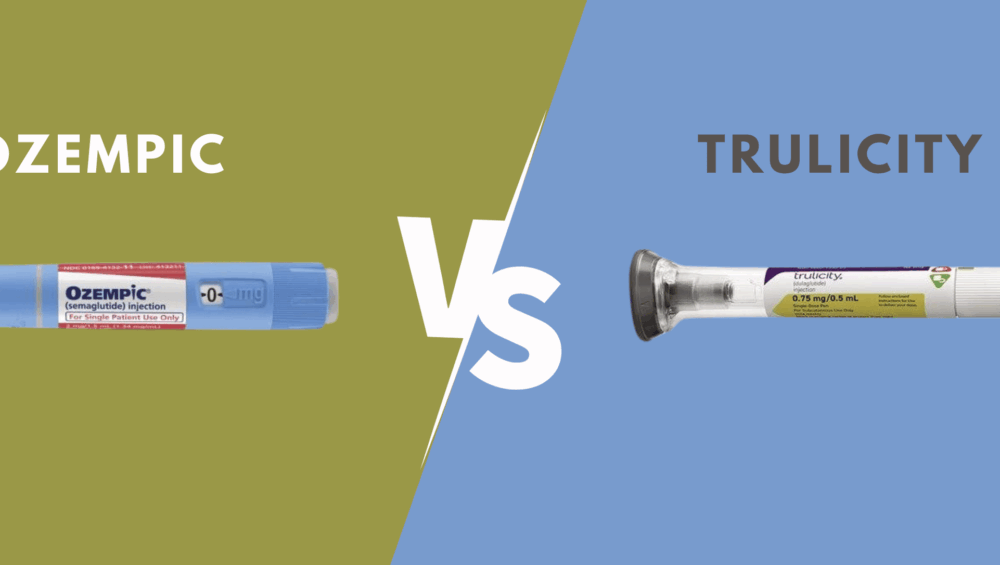When patients visit my clinic to discuss treatment options for type 2 diabetes and weight management, most of them will ask about Ozempic vs Trulicity Side Effects. Both belong to a class of drugs called GLP-1 receptor agonists. These medications mimic a natural hormone that helps regulate blood sugar and appetite.
Although they are often grouped, they are not the same. Are Ozempic and Trulicity the same? No. Each contains a different active ingredient, which means that while they work in similar ways, they can affect patients differently.
What I would like to do here is walk you through the most common and the more serious side effects I see in practice, so you know what to expect if you are considering either option.
Common Side Effects of Ozempic
Ozempic (semaglutide) is widely prescribed for type 2 diabetes management and has gained attention for its impact on weight loss. Most patients tolerate it well, but the gastrointestinal system is where we see the majority of side effects.
The most common include:
- Nausea
- Vomiting
- Diarrhea
- Constipation
- Stomach pain
These effects are usually more noticeable at the beginning of treatment or after the dose is increased. In my clinical experience, nausea often improves over time, but some patients discontinue treatment if symptoms persist.
Other possible side effects include mild fatigue, loss of appetite, and injection site reactions.
Common Side Effects of Trulicity
Trulicity (dulaglutide) works similarly, and its side effects often overlap with those of Ozempic. Gastrointestinal issues are also the most frequently reported.
The most common side effects are:
- Nausea
- Diarrhea
- Vomiting
- Indigestion
- Loss of appetite
Some patients also report mild abdominal discomfort, fatigue, or decreased energy. Just as with Ozempic, the body often adjusts after a few weeks, but not everyone experiences complete relief.
What Are the Worst Side Effects of Trulicity?
Patients are understandably worried about the more serious side effects of Trulicity. While most people only experience mild digestive issues, there are a few risks that deserve attention. The most important are pancreatitis (inflammation of the pancreas), significant gastrointestinal problems that do not improve, and dehydration that can sometimes affect kidney function. There have also been animal studies raising concern about thyroid tumors, though this has not been clearly shown in humans. When patients ask what are the worst side effects of Trulicity, I emphasize that although these risks are uncommon, they require immediate medical attention if symptoms such as severe abdominal pain, persistent vomiting, or unexplained lumps in the neck occur.
Comparing Ozempic and Trulicity Side Effects
When comparing the two drugs side by side, the general pattern is similar. Both cause gastrointestinal symptoms more frequently than anything else, and both carry warnings about pancreatitis and possible thyroid concerns. However, in practice, some patients tolerate one better than the other. Some find that Ozempic causes ongoing nausea, while others tolerate it better than Trulicity. It really varies from patient to patient, which is why I often remind people that we sometimes need to try one and see how their body responds before deciding which is the better fit.
This is why it is important to remember that medication response is individual. The best way to decide often comes down to how your body reacts, cost considerations, and your healthcare provider’s advice.
Cost Considerations
Another common question I receive is about affordability. One of the most practical questions patients bring up is how much Trulicity cost compared with Ozempic. Both can be costly without good insurance, sometimes reaching several hundred dollars a month. Prices differ from one pharmacy to another, and some patients lower their expenses through manufacturer savings cards or discount programs. In many cases, the cost ends up being just as influential in the decision as the side effect profile.
Final Thoughts: Ozempic vs Trulicity Side Effects
Ozempic and Trulicity are in the same class but not the same. Both can cause stomach side effects that vary by patient. Trulicity carries some risks that raise concern, which is why patients often want to know what the worst side effects of Trulicity are. While those risks are uncommon, they are important to keep in mind.
If you are considering one of these medications, have an open conversation with your doctor about your medical history, tolerance for side effects, and financial considerations (including how much Trulicity costs under your insurance plan). The best choice comes down to your medical history, how your body responds, and what you can reasonably afford. In the end, it is best to sit down with your doctor and talk about which medicine fits your health needs and your budget.







1 Comment
[…] GLP-1 medications offer numerous benefits, it’s essential to be aware of potential side effects. Most side effects are mild, but it’s crucial to discuss them with your healthcare provider. […]